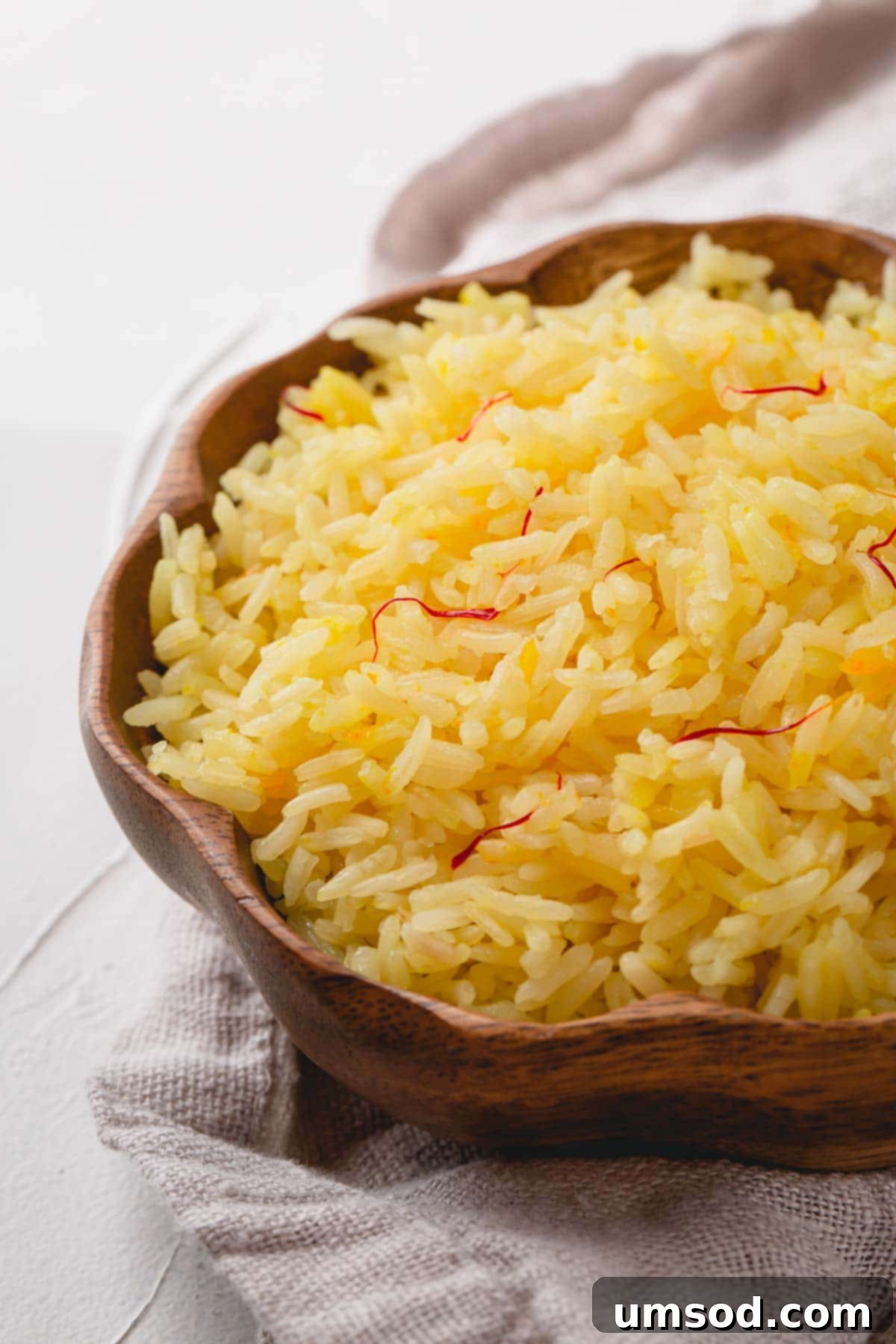Transform your everyday meal into an extraordinary culinary experience with this incredibly fluffy, aromatic, and vibrantly colored saffron rice. A timeless side dish, it brings a touch of elegance and exquisite flavor that perfectly complements a wide array of main courses, from robust meats to delicate seafood and savory vegetarian stews.
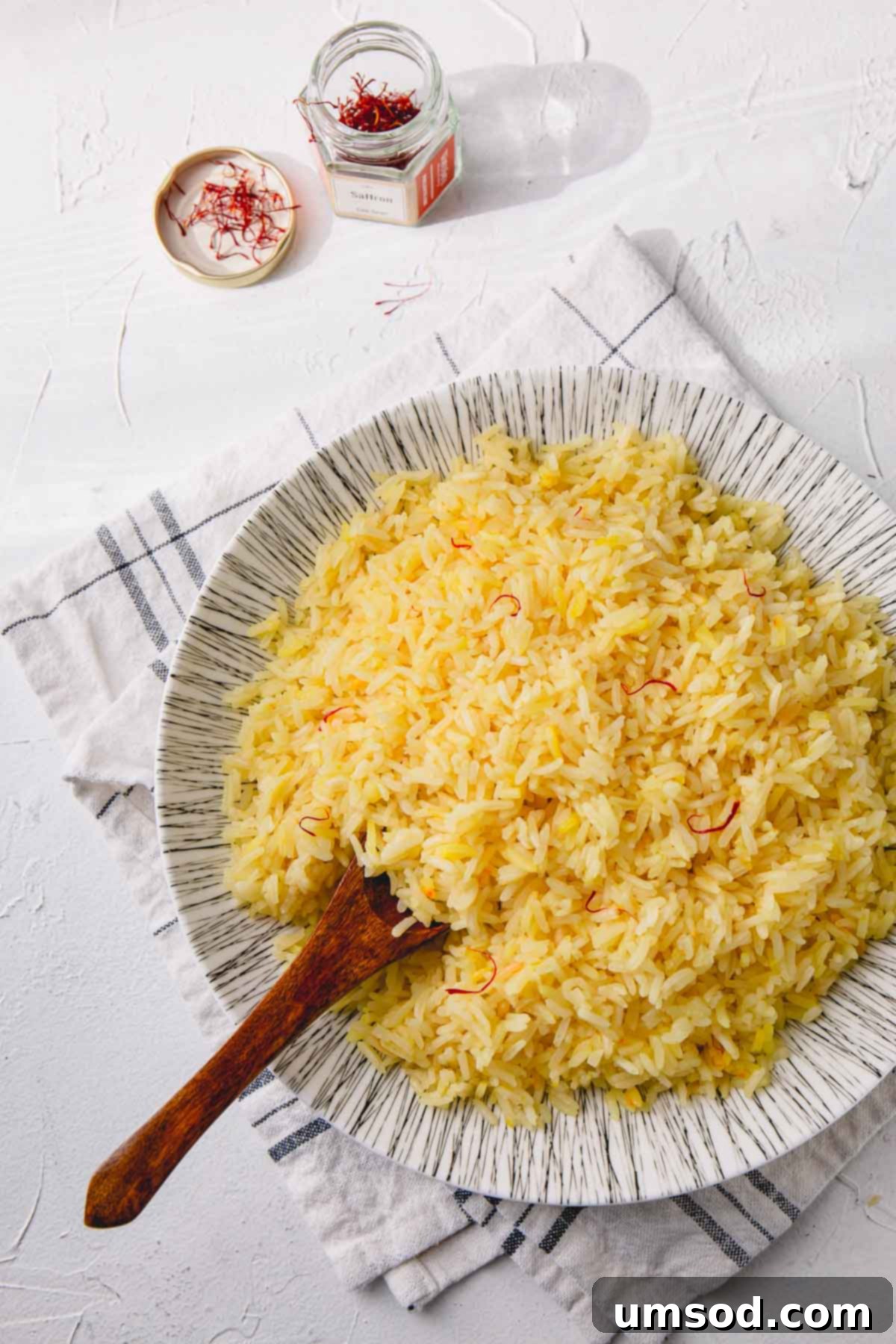
Why Golden Saffron Rice Will Become Your Go-To Side Dish
In many households, including ours, perfectly cooked rice is a cherished weekly staple. It’s the ultimate chameleon, effortlessly pairing with chicken, seafood, beef, curries, or virtually any main dish you can imagine. However, there are moments when plain white rice, as comforting as it is, simply doesn’t quite capture the desired sparkle for a special occasion or when you crave something truly elevated. If you’ve ever felt that desire for your rice to be more than just a background component, then this vibrant saffron rice recipe is your culinary solution.
The magic begins with just a pinch of saffron – the world’s most prized spice. This precious ingredient transforms humble rice into a side dish worthy of celebration. Its distinct aroma is a complex tapestry of floral, earthy, and subtly sweet notes, while its deep golden hue adds an unparalleled visual appeal to your plate. I particularly adore serving saffron rice alongside delicate seafood, like my pan-fried steelhead trout, where its subtle flavors enhance without overpowering.
Beyond its stunning appearance and captivating aroma, you’ll be amazed by how incredibly fluffy and separated each grain of this rice turns out. And here’s the best part: you don’t need any specialized kitchen gadgets like a rice cooker to achieve this perfection. Having cooked rice on the stovetop my entire life, I’ve honed a few invaluable tips and techniques that I’m excited to share. Rest assured, with these simple guidelines, you’ll achieve perfectly cooked rice every single time – no mushiness, no sticking, and absolutely no burning, I promise!

The Ultimate Secrets to Achieving Perfectly Fluffy Saffron Rice
Crafting impeccably fluffy saffron rice on the stovetop is a skill easily mastered with a few foundational principles. Forget gummy or undercooked grains; these essential tips will guide you to culinary success, ensuring your saffron rice is light, airy, and distinct with every bite.
- Master the Liquid-to-Rice Ratio: This is arguably the most critical factor. Too much liquid, and your rice will be soggy and mushy; too little, and you risk burnt or crunchy, undercooked grains. While precise measurements with measuring cups (typically 1.5 cups liquid per 1 cup of Basmati rice) are always reliable, my mom taught me a wonderfully intuitive trick: the liquid should come up about 1 inch above the rice, roughly the width of two fingers. This traditional method works exceptionally well and ensures just the right amount of steam.
- Cook Covered, Low, and Undisturbed: Patience is key during the cooking process. After bringing your rice mixture to a gentle boil over medium-high heat, immediately reduce the heat to its lowest setting. The most crucial step here is to resist the urge to peek! Keep the lid tightly sealed and let the rice cook gently for at least 15 minutes. This creates a steamy environment that cooks the rice evenly, allowing it to absorb the liquid fully without drying out or burning. Lifting the lid releases essential steam, which can disrupt the cooking process and lead to unevenly cooked rice.
- Allow for Resting and Gentle Fluffing: Once the cooking time is up, turn off the heat but keep the pot covered for another 5-10 minutes. This resting period allows the steam to redistribute, further plumping up the grains and ensuring they are perfectly tender. Afterwards, gently fluff the cooked rice with a wooden spoon or a fork. This technique separates the individual grains, preventing them from clumping together and creating that signature fluffy texture.
- Invest in High-Quality Saffron Threads: The star of this dish deserves attention. There are many varieties of saffron available, originating from regions like Spain, India, Afghanistan, and Iran. While the origin can offer clues, the most important indicator of quality is its color and composition. High-quality saffron boasts a deep, vivid red color, with minimal or no yellow styles. Yellow styles are less flavorful and contribute dead weight, diluting the potency and aroma. I personally favor the Afghan and Spanish varieties, which are typically of the highest grade (Coupe or Sargol). Avoid saffron powder, as its quality is difficult to verify and it often contains fillers. To delve deeper into the fascinating world of saffron, including its harvest, history, and grading systems, I highly recommend exploring a dedicated article on the subject – it’s truly captivating!
Essential Tip: Blooming Saffron
Before incorporating saffron threads into your dish, it’s vital to steep them in hot water. This process, often referred to as “blooming,” is crucial for extracting and intensifying saffron’s sweet floral aroma and vibrant golden-red color. It ensures that every grain of rice is beautifully infused with its unique essence and hue.
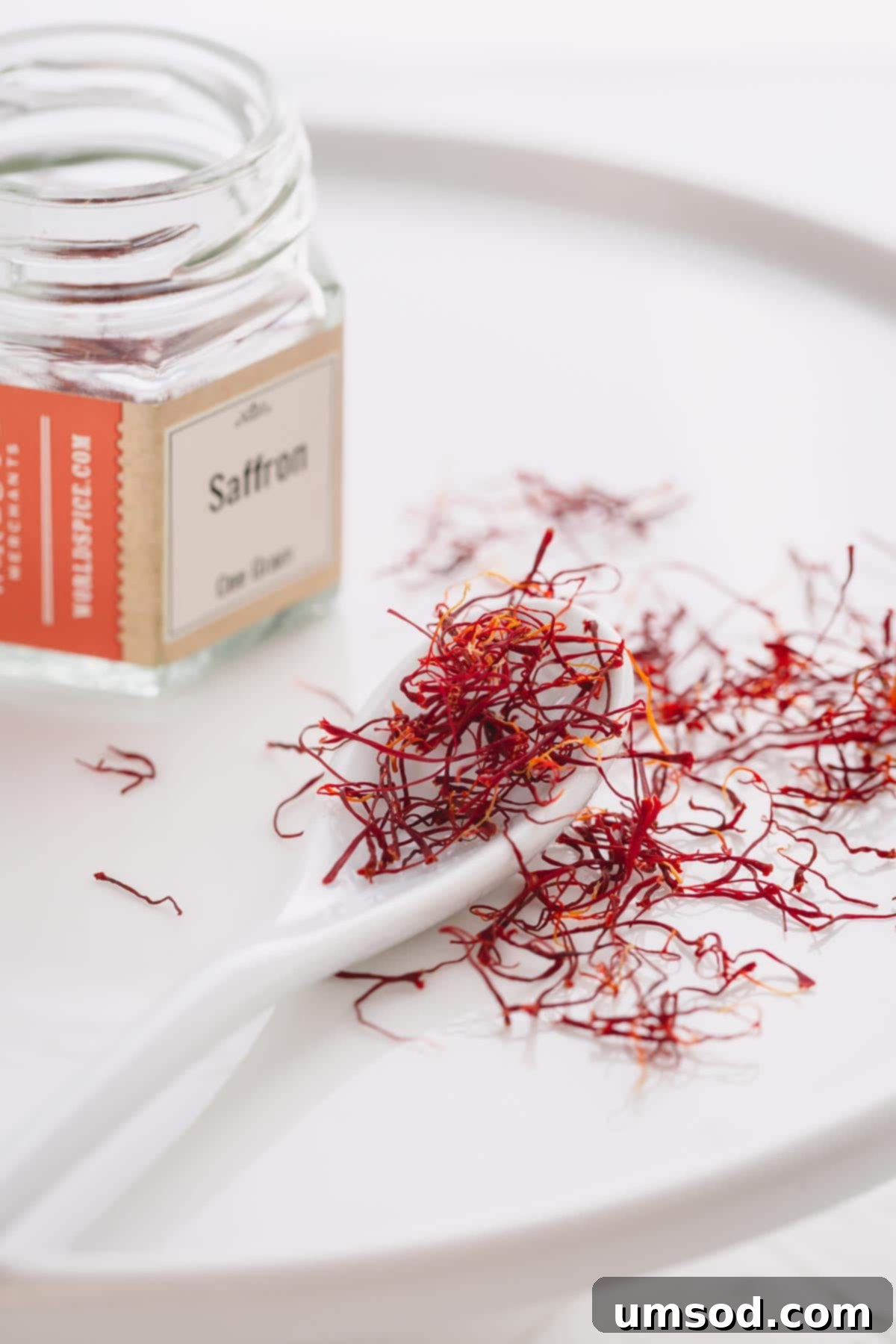
Crafting This Flavor-Packed Saffron Rice: A Step-by-Step Guide
Creating this exquisite saffron rice involves layering flavors to achieve a truly complex and satisfying profile. It’s not just about the saffron; it’s about building depth from the very beginning.
First, we’ll start by gently toasting the basmati rice in melted unsalted butter for a few minutes. This initial step is more than just cooking; it’s about building the first foundational layer of flavor, imparting a subtle nuttiness to the rice grains and helping them to separate beautifully later on.

Once the butter has been fully absorbed, coating each grain, we’ll introduce the liquid element: savory chicken or vegetable stock. This adds another rich layer of flavor, far surpassing what plain water could offer. Crucially, at this stage, we’ll also stir in our beautifully bloomed saffron, ensuring its vibrant color and exquisite aroma are evenly distributed throughout the rice.
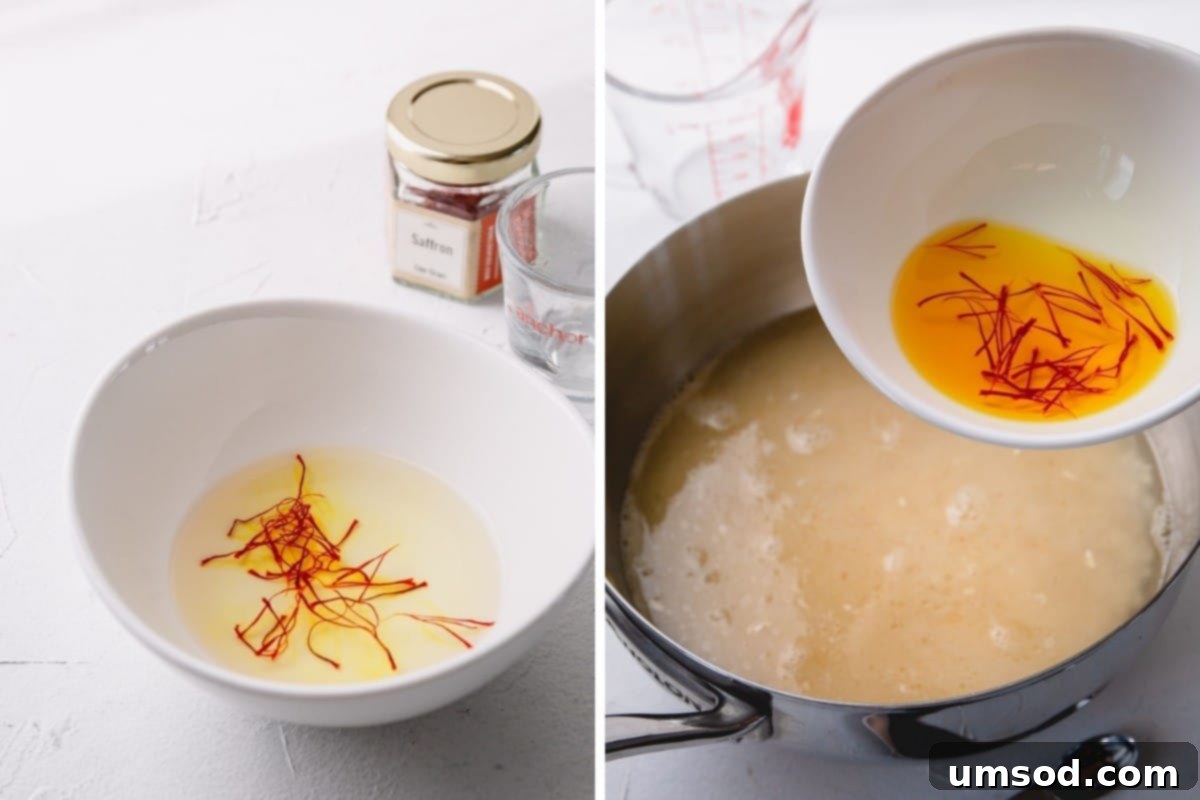
The rice is then brought to a boil, covered, and allowed to simmer gently until all the liquid is absorbed, and the grains are tender and fluffy. The result is a truly flavorful and visually stunning rice dish, with a captivating golden hue and an intoxicating aroma that promises to be the perfect accompaniment to almost any meal you serve.
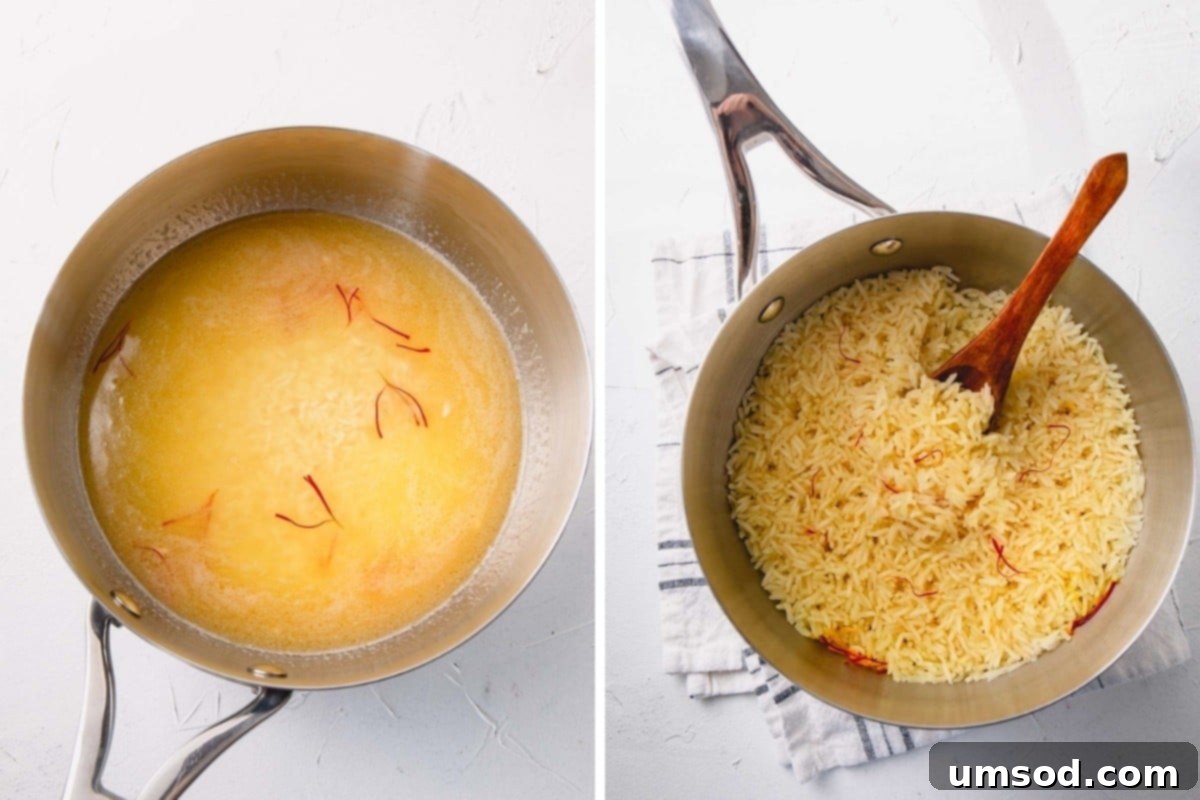

Frequently Asked Questions About Saffron Rice
Can I make this recipe vegetarian?
Absolutely! This recipe is incredibly versatile and can easily be adapted for vegetarian diets. Simply replace the chicken stock with an equal amount of high-quality vegetable stock. Opt for a low-sodium vegetable stock to control the overall saltiness of your dish, allowing the delicate saffron flavors to truly shine. The rich savory notes of vegetable stock will still provide a wonderful depth of flavor.
Is there an alternative for basmati rice?
While basmati rice is highly recommended for its long, slender grains and fragrant aroma, which contribute to the exceptionally fluffy texture of this dish, you can certainly substitute jasmine rice in a pinch. Jasmine rice is another aromatic long-grain variety that will also yield a pleasingly fluffy result. For best results, avoid short-grain or medium-grain rices, as they tend to be starchier and can result in a stickier texture.
How to store leftover saffron rice:
Proper storage ensures you can enjoy your delicious saffron rice for days to come. Store any leftover saffron rice in an airtight container in the refrigerator for up to 4 days. When reheating, a microwave works perfectly; simply heat until piping hot. If you find the rice has dried out slightly upon reheating, add a small splash of water or a knob of butter before microwaving to restore its moisture and tenderness.
For longer storage, saffron rice freezes beautifully. Allow the cooked rice to cool completely, then transfer it to freezer bags or airtight freezer-safe containers. It can be stored in the freezer for up to 3 months. When you’re ready to enjoy it, thaw it in the refrigerator overnight, then reheat as directed above, adding a small amount of water if needed to prevent dryness.
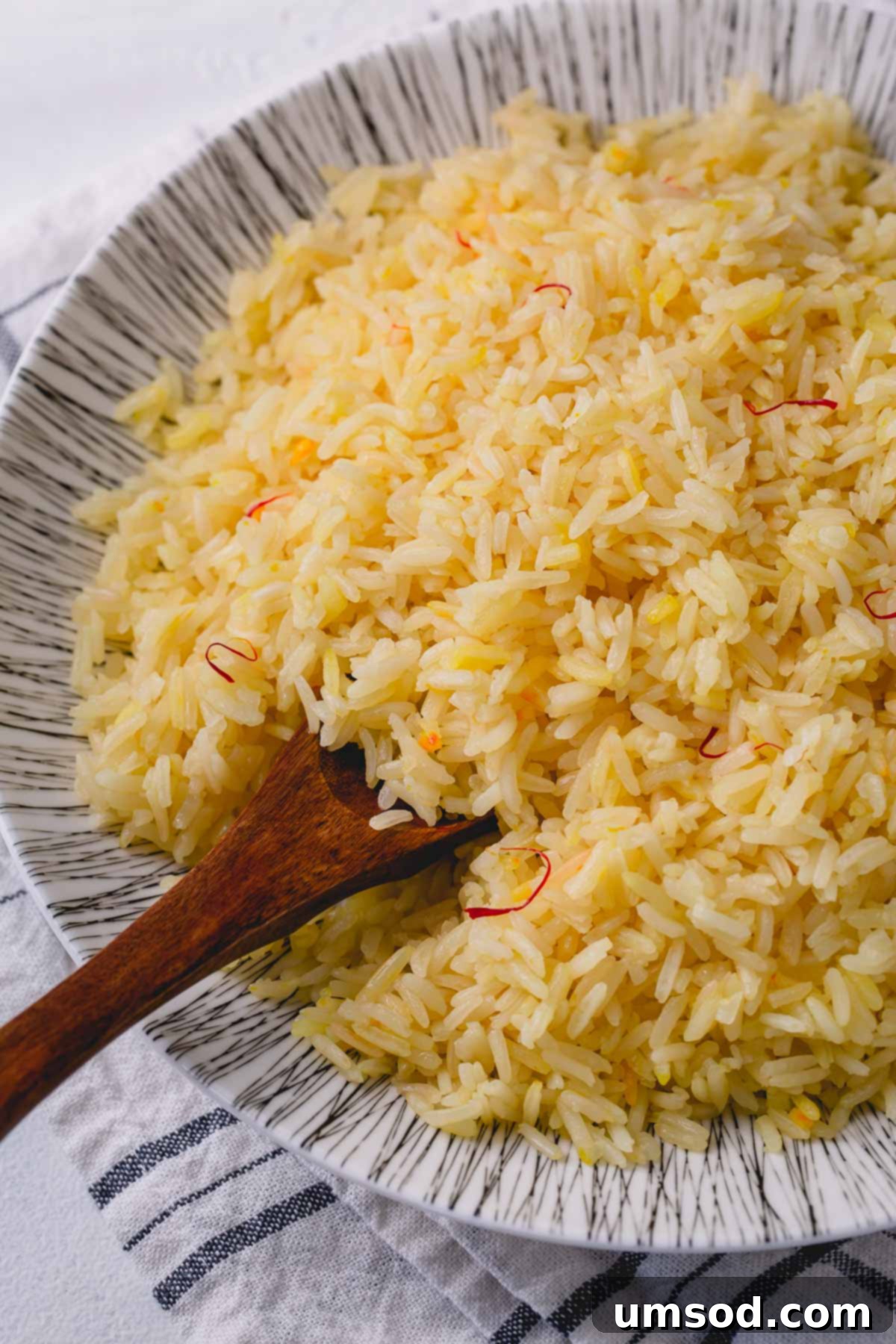
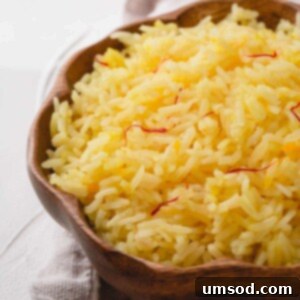
Saffron Rice: The Golden Touch
Shinee Davaakhuu
30 minutes
4
servings
Comment
Print Recipe
Ingredients
-
1/8 teaspoon
saffron threads
(High-quality, deep red. See Note 1 below for recommendations.) -
2 tablespoons
unsalted butter -
1 cup
(185g) basmati rice
(Rinsed thoroughly.) -
1 ½ cups
(360ml) low sodium chicken stock
or vegetable stock -
½ teaspoon
coarse kosher salt
Instructions
- To bloom saffron: Place saffron threads in a small bowl. Pour 2 tablespoons of boiling water over them. Let the saffron steep and bloom for 10 minutes; this will release its vibrant color and intense aroma.
- Meanwhile, melt the unsalted butter in a medium saucepan over medium-high heat. Ensure your saucepan has a tight-fitting lid (a 2.5-quart saucepan works perfectly for this quantity of rice).
- Add the rinsed basmati rice to the melted butter and cook for 3-5 minutes, stirring constantly. This step lightly toasts the rice, adding a subtle nutty flavor and helping to keep the grains separate.
- Pour in the chicken (or vegetable) stock, add the coarse kosher salt, and gently stir in the bloomed saffron along with its steeping water.
- Increase the heat to medium-high, cover the saucepan tightly with its lid, and bring the mixture to a rapid boil.
- Immediately reduce the heat to low and continue to cook, keeping the lid securely on, until all the liquid is absorbed and the rice is fully cooked and tender. This typically takes about 15 minutes. It is crucial NOT to open the lid while the rice is cooking, as this releases essential steam.
- Once cooked, remove the pot from the heat and let it rest, still covered, for another 5-10 minutes. This allows the grains to steam further and become exceptionally fluffy. Finally, carefully fluff the rice with a wooden spoon or a fork to separate the grains, then serve immediately and enjoy!
⭐️ Did you make this recipe?
Please leave a review and let us know how you liked it!
Tips & Notes
Note 2: While basmati rice is preferred for its unique texture and aroma, you can substitute jasmine rice if basmati is unavailable. It will still yield a delicious and aromatic result!
Nutrition
251kcal
40g
6g
7g
1g
422mg
Side Dish
American
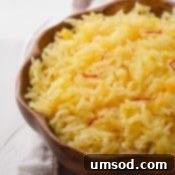
Did you make this?
Leave a rating and your feedback. Thank you!
You may also like:
Pan-Fried Steelhead Trout with Lemon Butter Sauce
